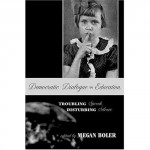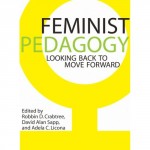As I mentioned a couple of weeks ago, I am in the process of prepping for the two courses that I will be teaching this fall at the U of M: Feminist Pedagogies and Queering Theory. In both classes, I plan to use blogs. In addition to making blog writing part of the students’ assignments, I also want to devote (at least) one or two class sessions to reading and discussing blogs as tools for critical thinking, community building and activism. In preparation for these class sessions, I will devote some entries in this blog to reflecting on sources that I might use.
BLOGGING FEMINISM: (WEB) SITES OF RESISTANCE
Part of The Scholar and Feminist Online (S&F) out of Barnard College (a very cool resource for feminist scholarship, edited by one of my favorite queer/feminist ethicists Janet Jakobsen), this special issue from spring 2007 is dedicated to feminist blogs. While all of the articles are great, I think Shira Tarrant’s The Little FemBlog that Wasn’t is especially helpful for thinking about how to use blogs in a feminist classroom.
Here are some insights that I have gleaned from Tarrant’s “The Little FemBlog that Wasn’t” (many of which resonate with my own experiences in the classroom):
In order to get students to use the blog, you must make it worth their while. You must build blog assignments into your course syllabus and make the entries worth points. According to Tarrant, while students might be excited about the prospect of sharing their thoughts with each other on the blog, when the pressure of other course work + readings hits, blog writing-that-is-voluntary is the first thing to go. Students will more often than not prioritize work that is graded and/or that affects their final grade.
I agree. Just compare two of my blogs, here and here. Can you guess which one had blog assignments built into the syllabus? One additional note: Making blog entries as an option for earning points (but not making it the required way in which to earn those points) doesn’t work that well either. When given the choice, students–even the ones who excitedly proclaim on the first day that they LOVE blogs, especially feminist ones!–will pick the other (non-blog) option.
Blog posts can be done at any time of the day or night. This advantage enables students to process/express/share their thoughts about an issue or the reading immediately, and at 2 AM if they want, instead of having to wait until a more reasonable time (like during class or office hours). Tarrant writes:
As I see it, this is a true advantage of blogging with students: The hours after midnight are often ripe for deep thoughts but awful for calling professors or classmates to talk them over. How else but by blogging can students continue a classroom debate about compelling issues when the ideas feel so fresh and urgent and yet it is so late at night?
I do see a downside to this, however. The immediacy of the blog also enables students to post (potentially) heated entries that are highly charged with anger, confusion, or frustration and are written before students have processed (and thought through) the ideas that they are writing about. While emotion and passion can be good things for your writing, if they are expressed without any amount of reflection, they can produce entries that lack substance, are irresponsible, and don’t contribute to a critical engagement with the idea or reading. (And, as I suggest in an earlier entry on blog writing, they end up serving as brain dumps.) The trick, I think, is to find a way to balance the benefits of immediate access (to expressing ideas, to connecting with others) with the necessity of posting thoughtful, responsible and accountable entries.
Hmmm….As I was writing this last little bit, I started to wonder: What role should emotion have in blog entries? How much processing should be requried when writing a blog entry? Could somebody’s rant be turned into a teaching moment? If so, how?
Blog entries are risky and can generate a lot of anxiety for students. This bit of insight is especially important for me to remember. Because I see so much value in blogging and because I have a higher level of confidence and authority as the professor, it is easy to forget that putting your ideas out there for others to read can be very intimidating and uncomfortable. As Tarrant argues, blog writing is not safe. It demands that you leave your comfort zone and engage in risky behavior: You risk being wrong. You risk saying something thoughtless or offensive. You put yourself at risk by exposing your lack of knowledge and your uncertainty. Here is what Tarrant writes about it:
That said, the greater the risk, the greater the possibility for new ideas. The best new thoughts never come by playing it safe. Blogging means that students will weigh in freely and creatively, which is perhaps riskier than processing information through the safety and privacy of more traditional forms of academic research (which, for the record, I also use quite rigorously). Academic research may be more deliberately thought-out, but it leaves less room for the impulsiveness, spontaneity, and immediacy that the Internet offers.
Again, I agree. But I am still left with a troubling question: How do you simultaneously encourage creativity/more freedom to express yourself and thoughtful, serious, critical attention to ideas, readings, others’ entries? I think this is possible, but it does require some thinking–in terms of course/assignment planning–about how to create and maintain a balance between creativity and structure.
Here are two other issues that blogging and the idea of risk (in terms of the problems it creates and the possibilities it generates) raises for me in the classroom:
- Because blogs are supposed to be creative and less structured, they can be very risky for students who want all of the answers and who strongly desire structure. In one of my classes this past year, several students grumbled about the lack of structure/guidance in the blog assignment. Just what do you want us to say? Translation: Please give me the exact formula for how to get all of the points for this assignment. Or, please tell me exactly how to write this entry so I don’t look stupid. As I have tried to tell these students, too much structure can stifle creativity. I want my students to think for themselves. And I want to extend them the freedom to work out how to translate that thinking into an effective (interesting, engaging, productive) blog entry. (But, maybe I should be clearer about all of this. I could write a little blurb about the lack of structure and include it in the syllabus/blog assignment handout).
- The lack of structure and the desire to have students express themselves in creative ways, can be a little troubling for me as I work out how to evaluate students’ posts. Like Tarrant advised, students need blog entries to be graded or to be worth points. But what is the best way to evaluate blog entries, especially ones that include bits of personal experience? One popular understanding of the blog (as a medium) is that it is an online diary/journal. If there is some truth to this idea, grading students’ personal reflections is tricky. I try to emphasize the importance of demonstrating a *serious* engagement with the text and the necessity of using specific examples and/or evidence from the text to support your entry.
Blogs work better in the classroom when we (teachers and students) read and think more about what kind of teaching/learning practice blogging is (and/or could be). At the end of her essay, Tarrant discusses the value of blogs in feminist classroom for “open[ing] possibilities for a democratic learning process” and “help[ing]to achieve feminist goals in the virtual world.” She argues that we need to discuss how feminist pedagogy and internet technology can work together. And we need to think about how engaging with blogs (through writing entries and reading/posting comments on others’ entries and blogs) could help to encourage feminist critical practices, develop a feminst classroom, and foster feminist communtities.
This is an especially important point. Students and teachers need to explore (and think critically) about how and why to use blogs. Blogs aren’t just online journals that are used to record the “excruciating minutia” of our lives or our thinking about an idea or text. They aren’t just cool and trendy ways to demonstrate to students that we, as teachers, are hip and relevant. And, they aren’t just distractions (and a lot of extra effort) from the real (as in serious, academic, important) work that goes on inside/outside the classroom. I see tremendous potential in using blogs in my teaching, both in the classroom, and as a way to encourage students to think critically. To develop that potential, feminist teachers need to spend some time creating blogging strategies, theories, and assignments. And they need to share their ideas with others. That’s what I am trying to do here. That’s what Tarrant is doing in her essay. And, that’s what these authors are doing here and here.
A final thought: A couple of weeks ago I asked STA, who has written a blog since 2002 (or maybe even earlier?), to reflect on why he thinks blogs are important. Here it is:
Blogs are valuable in much the same way that the Internet as a whole is valuable — they have opened up new channels for self-expression and communication. I suspect many of us have long harbored the inclination to write in the fashion of a blog, but there have been few outlets. The closest I came to writing a blog, before blogs, was my weekly column in the college newspaper, and writing the blog fills the same need for me. It’s a way to gather my thoughts — not simply to collect them, but to stimulate them to fuller realization — and to put them out there for the larger world to experience and respond to. Personal blogs are perhaps more often likened to diaries than to newspaper columns, but in fact I think they are closer to the latter. A diary is typically written solely for oneself, with the intention that it will not be read by anyone else, at least while we’re alive. And although the joke is that most blogs have an “audience of one,” blogs still are public, and can be viewed by anyone, at any time. They’re a public performance, of sorts, and force us, if we’re honest with ourselves, to critically examine our words for consistency and “truth” — whatever form that may take — because we’re opening ourselves up to criticism from others. So, even if your blog really does have an audience of one, it’s not necessarily the same you who would be reading your secret diary entries.


